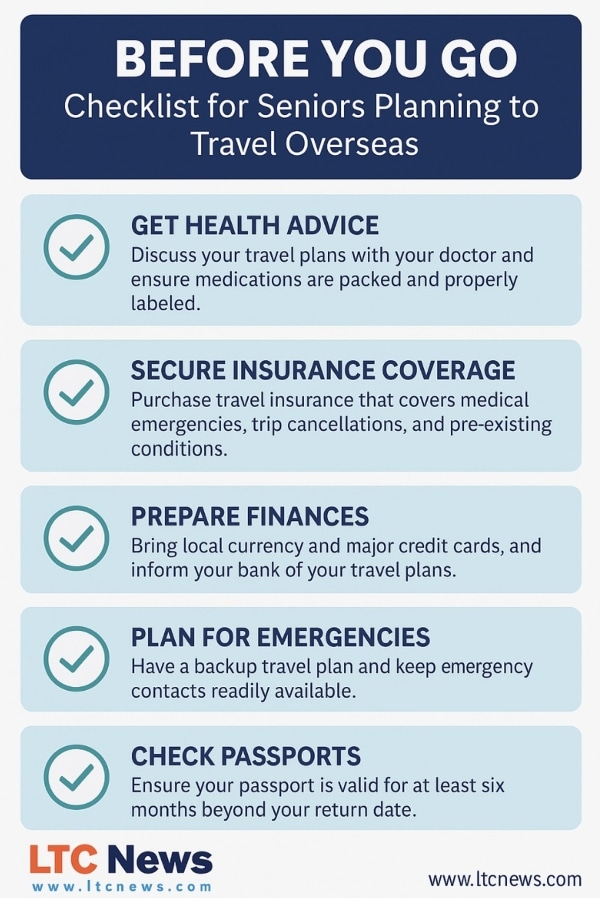Travel as Therapy: The World’s Most Relaxing Destinations for Your Mind and Body

Table of Contents
- River Cruises: Slow Journeys for a Calmer Mind
- Forest Bathing and Ecotherapy: Healing Among Trees
- Historic Spa Towns and Wellness Retreats: Hydrotherapy with Heritage
- Outdoor and Surf Therapy: Gentle Movement in Nature
- The Evidence Behind Travel as Therapy
- Planning Tips for Retirees Traveling Overseas
- Traveling With Your Caregiver: Support and Shared Reward
- Bringing It All Together
You’ve earned your retirement. But beyond the freedom from alarm clocks and work deadlines, you may also find yourself needing a deeper sense of renewal—mentally, emotionally, and physically. Regular travel can help. Studies show that taking two vacations per year correlates with a 30 percent lower risk of depression and improved sleep quality among adults over 50.
For many retirees, trips provide both adventure and therapy: a chance to reset your nervous system, deepen social connections, and reduce stress hormones like cortisol.
River Cruises: Slow Journeys for a Calmer Mind
There’s something inherently therapeutic about drifting along the renowned rivers in Europe. European itineraries—such as the Danube through Austria and Hungary, the Rhine past Germany’s storybook vineyards, or the Rhône winding near Provence—are designed with accessibility and comfort in mind.
You’ll board in historic city centers, unpack once, and enjoy flat terrain and optional low-impact excursions. This slower tempo can reduce travel anxiety, while immersive scenery and cultural stops stimulate your mind without exhausting your body. Many retirees say river journeys combine the benefits of guided tours with the serenity of small-scale cruising.
Forest Bathing and Ecotherapy: Healing Among Trees
“Forest bathing,” or shinrin-yoku, is backed by decades of research showing lowered blood pressure, enhanced immunity, and reduced stress after guided time in the woods.
Europe has embraced the science, creating certified “healing forests” for structured nature therapy:
- Bad Füssing, Bad Wörishofen, and Bad Kötzting (Germany): Spa towns offering formal forest therapy programs.
- Heringsdorf, Usedom (Germany): The country’s first designated healing forest, opened in 2016 with sensory trails and movement zones.
- Heilwald Senftenberg (Austria): Austria’s first certified forest-therapy site for guided mindfulness walks.
Beyond official programs, iconic woodlands such as the Black Forest in Germany or Hallerbos (“Blue Forest”) in Belgium invite quiet strolls through ancient trees. Research shows these environments lower cortisol, improve mood, and spark creativity—perfect for resetting your mind in retirement.
Water’s Calming Power: “Blue Mind” Therapy
Marine biologist Wallace J. Nichols coined the term “Blue Mind” to describe the meditative state humans enter near water. Whether standing at the ocean’s edge or walking by an alpine lake, you experience measurable physiological relaxation.
Therapeutic examples across Europe include:
- Cornwall (England): Gentle coastal walks with dramatic sea vistas.
- Lake Bled (Slovenia): A glassy alpine lake ideal for short paddles or reflective strolls.

Many Mediterranean resorts also offer thalassotherapy—treatments using seawater and marine aerosols—to alleviate stress and aid circulation. Alternating between saltwater pools, sea breezes, and rest time can bring profound calm.
Historic Spa Towns and Wellness Retreats: Hydrotherapy with Heritage
Europe’s spa towns have drawn wellness seekers for centuries. The UNESCO-recognized Great Spa Towns of Europe include Baden-Baden (Germany), Karlovy Vary (Czechia), Montecatini Terme (Italy), Vichy (France), and Bath (U.K.), among others. Each is built around mineral springs and rituals of restorative bathing.
Highlights for today’s traveler:
- Friedrichsbad, Baden-Baden: A 17-stage bath ritual combining Roman and Irish traditions.
- Montecatini Terme (Italy): Thermal mud baths and elegant promenades.
- Széchenyi Thermal Bath (Budapest): Medicinal pools and saunas in Europe’s largest thermal complex.
- Inchydoney Island Lodge & Spa (Ireland): Sea-based relaxation and thalassotherapy.
Modern wellness resorts now merge classic hydrotherapy with forest therapy, yoga, and nutrition programs—perfect if you’re seeking both tradition and innovation.
Outdoor and Surf Therapy: Gentle Movement in Nature
Not every traveler wants to stay still. Hiking, low-impact trekking, or therapeutic surf sessions can deliver the mental health benefits of exercise with the healing power of nature. Portugal’s Algarve coast and northern Spain both host surf programs adapted for adults, while Germany’s Southern Black Forest offers tranquil waterfalls and accessible trails for guided walks.
Outdoor therapy combines mindful movement, social interaction, and exposure to natural beauty—elements shown to improve mood regulation and resilience at any age.
The Evidence Behind Travel as Therapy
Recent surveys by the Global Wellness Institute and the U.S. Travel Association show:
- Adults over 50 who take at least two vacations annually report up to 30% lower depression rates.
- 75% of travelers notice reduced stress after a trip.
- 80% of travelers report improved mood and better sleep.
For retirees, this isn’t just leisure—it’s a health strategy. Travel interrupts sedentary routines, exposes you to new sensory environments, and fosters social contact—all protective factors for cognitive and emotional health.

Planning Tips for Retirees Traveling Overseas
Traveling abroad after 65 can be deeply rewarding — but it also comes with extra considerations. You’ve worked hard for this freedom; a little preparation helps you enjoy it safely and confidently.
Check Passports and Visas Early
Many countries require at least six months of passport validity beyond your return date. Renew your passport if it’s nearing expiration. Some destinations also need entry visas or online travel authorizations. Verify requirements with your destination’s embassy well in advance.
- Get More Information: U.S. State Department - Travelers in Europe
Citizens of the United States need ETIAS to travel to Europe. ETIAS, the European Travel Information and Authorization System, will be operational from 2026. Review which European countries require ETIAS, and what you need to apply from the U.S.

Understand Travel Insurance vs. Medicare
Original Medicare does not cover healthcare outside the United States, except in very limited circumstances. A supplemental Medigap plan may provide partial overseas coverage, but many retirees still buy separate travel medical insurance.
Make sure your policy covers pre-existing conditions, emergency evacuation, and trip interruption.
While you would not expect to need long-term care when traveling overseas, it can, and does happen when you may not be ready to return to the United States following a medical event or accident. Some Long-Term Care Insurance policies offer some international benefits.
Carry Medical Records and Medications
Bring an updated list of your medications, allergies, and medical conditions in both digital and paper form. Pack extra medication in original containers and divide it between carry-on and checked luggage.
Ask your doctor for a letter explaining any controlled substances or injectable medicines you’re bringing.
Schedule a Pre-Trip Checkup
Visit your primary care physician or a travel medicine clinic 6–8 weeks before departure. You may need destination-specific vaccines or boosters (such as yellow fever, typhoid, or updated COVID-19 shots). Ask about preventive steps like compression socks for long flights or managing chronic conditions while traveling.
Plan for Mobility and Accessibility
Call hotels and tour operators to confirm elevator access, step-free entrances, and mobility aids. Ask about wheelchair-friendly rooms, dietary accommodations, and medical services nearby. Many cruise lines and tour companies offer senior-friendly excursions or on-call medical staff.
Secure Your Finances
Notify your bank and credit card companies of your travel dates. Bring at least two payment options and a small amount of local currency. Consider using a money belt or RFID-blocking wallet to reduce theft risk.
Stay Connected
Carry an unlocked phone with an international plan or buy a local SIM card. Some U.S. carriers include international roaming automatically on many plans (so your phone just works when you land). Be sure to check before you go.
Keep a printed list of emergency contacts and your country’s embassy information. If you use caregiving support at home, arrange for backup care and communicate your travel plans with family.
Quick tips:
- Turn on Data Roaming before you go.
- Expect speed caps after the included high-speed allotment.
- Save by using Wi-Fi calling/WhatsApp on hotel Wi-Fi.
Jet Lag, Hydration, and DVT Risk
Adjust your sleep schedule a few days before you travel. Drink water regularly on flights, and take short walks during layovers to reduce stiffness and the risk of deep vein thrombosis (DVT).
Deep vein thrombosis (DVT) is a blood clot that forms in a deep vein—most often in your calf or thigh. Your risk goes up with age, especially after 60, and with long periods of sitting, like on overseas flights or bus and car rides. Other risk factors include a prior clot, recent surgery or hospitalization, cancer, hormone therapy, smoking, obesity, and limited mobility.
You should pay attention since the warning signs can be subtle: one leg that’s swollen, tender, warm, or red. If you develop sudden chest pain, shortness of breath, coughing up blood, or fainting, treat it as an emergency because a clot can travel to the lungs (pulmonary embolism).
Before you travel, ask your doctor about your personal risk—especially if you’ve had a DVT before or recent surgery. If you’re concerned about circulation or vein health before long-distance travel, consult your doctor or, if you live in Michigan, experts such as Taylor Vein Specialists can provide guidance on prevention and treatment options. A vein or vascular specialist will evaluate your personal risk factors for clotting or circulation problems before you travel. On the trip, keep blood moving: choose an aisle seat if possible, stand or walk every hour, and do ankle circles and calf squeezes while seated.
Stay well-hydrated, limit alcohol and sedatives, wear loose clothing, and consider properly fitted graduated compression stockings (often 15–20 or 20–30 mmHg) if your clinician recommends them.
If you take a blood thinner, carry it in your hand luggage, and confirm a dosing plan across time zones. Seek medical care promptly if symptoms appear during travel or in the weeks after you return.
Traveling With Your Caregiver: Support and Shared Reward
For some older adults, a trusted home caregiver is not just a helper but a lifeline. If you’re managing chronic conditions, mobility limitations, or daily living needs, bringing your caregiver on an overseas trip can turn an otherwise stressful experience into an enjoyable adventure.
Having a familiar professional by your side ensures medication schedules stay on track, mobility challenges are addressed quickly, and health issues are monitored without disrupting your vacation.
Bringing a caregiver isn’t only practical — it’s also deeply rewarding.
Many retirees see this as a way to thank the person who’s been by their side for years. Traveling together allows your caregiver to experience new cultures, enjoy rest days, and strengthen the bond you’ve built. This shared time can boost morale for both of you, especially after years of caregiving routines.
If you’re considering taking your caregiver abroad, plan ahead carefully:
- Work Out Logistics Early: Include your caregiver in the trip-planning stage. Check visa and work requirements for your destination country; some may require special entry permits if the caregiver is considered an employee.
- Budget for Travel Costs: Factor in airfare, lodging, meals, and insurance for your caregiver. If you have a Long-Term Care Insurance policy, verify whether travel-related caregiving expenses may be reimbursed or partially covered when you’re away from home.
- Define Roles and Downtime: Outline clear expectations about caregiving duties versus free time. This helps both of you enjoy the experience without burnout.
- Communicate With Family: Let relatives or backup caregivers at home know your plans so they can assist with any needs that arise while you’re abroad.
Bringing your caregiver also offers peace of mind. If you experience an emergency or hospitalization overseas, you’ll have someone who knows your medical history, medications, and preferences on hand to advocate for you. This can be invaluable in countries where language barriers or different medical systems could complicate care.
Ultimately, including your caregiver on a trip isn’t just about support. It’s about recognizing the role they’ve played in your life, sharing meaningful experiences, and creating memories together outside the daily routine of care.
- Need a Professional Caregiver: Use the LTC News Caregiver Directory, which has over 80,000 care providers nationwide.
Bringing It All Together
Travel can be much more than a change of scenery. Whether you’re floating down the Danube, meditating in a healing forest, soaking in thermal waters, or strolling on a quiet beach, these experiences tap into powerful biological pathways that reduce stress, elevate mood, and restore energy.
In retirement, when you have the freedom to design your days, building restorative travel into your life can be one of the best investments you make for your health and happiness.


